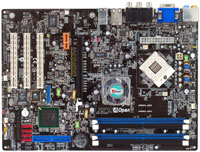Intel Core Duo (Yonah) Performance Preview - Part II
by Anand Lal Shimpi on December 19, 2005 12:55 PM EST- Posted in
- CPUs
Another issue that we had with the first article was that our comparison to the Pentium M was based on using an Intel 865 chipset; more specifically, using ASUS' CT-479 adapter and their P4P800-SE motherboard. While the motherboard itself performs quite well, we wanted a more even comparison between the Pentium M and the upcoming Core Duo processor.
 We turned to AOpen and they provided us with their i915Ga-HFS motherboard, based on Intel's mobile 915 express chipset with native support for the Pentium M processor. The biggest difference between our AOpen 915 platform and the 865 platform that we tested back in March? The 915 platform supports DDR2 memory, just like the 945 platform that we used with the Core Duo. Being able to use the exact same memory technology across both platforms removed yet another variable from our comparison, but frankly, it wasn't going to do much to the performance breakdown between the two chips.
We turned to AOpen and they provided us with their i915Ga-HFS motherboard, based on Intel's mobile 915 express chipset with native support for the Pentium M processor. The biggest difference between our AOpen 915 platform and the 865 platform that we tested back in March? The 915 platform supports DDR2 memory, just like the 945 platform that we used with the Core Duo. Being able to use the exact same memory technology across both platforms removed yet another variable from our comparison, but frankly, it wasn't going to do much to the performance breakdown between the two chips.
AOpen's board worked well during our testing, although we did have the occasional issue where the system would not POST. The issue wasn't readily repeatable, but it did happen a few times during our testing.
The only other quirk that we ran into with the AOpen board was the fact that it features absolutely no legacy ports on its I/O panel. There is support for a single PS/2 port that requires a separate bracket to be installed in your case (provided with the motherboard). Given the prevalence of USB keyboards and mice these days, it's not that big of an issue. We only mention it because the majority of our KVMs in-house are still PS/2 based.
We paired AOpen's 915 board with a Pentium M 760, which is based on the 90nm Dothan core running at 2.0GHz with a 533MHz FSB. So while the FSB speed is slower than the Core Duo that we're testing, the identical clock speed is helpful in a direct comparison between the two chips.










103 Comments
View All Comments
ncage - Monday, December 19, 2005 - link
I swear this is the best first post ive ever seen. Good Post Alex. Ya competition is very good for the market. I think intel is starting to get back on track where they need to be. It all comes down to clock speed and cost at launch. What improvements will we see with the launch of amd's next chip other than ddr2 which right now i don't really care about and possibly more cores (at least for the opteron). I am not dogging amd because for about 3-4 years ive only used AMD chips but i think amd has to raise the bar even more.Calin - Tuesday, December 20, 2005 - link
DDR2 for AMD would be great at least for a few things:moving to single channel DDR2 memory would decrease costs (in mainboards and a bit in processors)
moving integrated graphics to single or dual channel DDR2 would increase graphic performance and overall system performance in relation to single or dual channel DDR
As for the high end, I really don't think an increase in memory bandwidth will help - not even for dual core processors. Maybe for a quad core, but quad cores are certainly for servers, and I don't know about registered DDR2 memory to be used in them.
Hmmm, you could try an Opteron Dual Core with single channel DDR memory, to see how much performance would be lost by going quad core, dual DDR.
mlittl3 - Monday, December 19, 2005 - link
I agree with both Alex and ncage. I really disliked Intel all through out the Pentium4/Net-burst days. They were just releasing marchitecture with no improvements whatsoever. I loved AMD for their innovation and performance/watt.Now both companies are equal but I don't think we will see the huge fall AMD suffered from when Intel released the Pentium 4 to compete with the Athlon/K7 architecture. The beauty of competition is showing its bright colors right now. If we only had Intel, we would have a very hot/power consuming inefficient Pentium 4 based on net-burst to play Quake 4 at 5fps right now.
Its time for the fanboys to turnover a new leaf. Go Intel and AMD!!! We love both you guys.